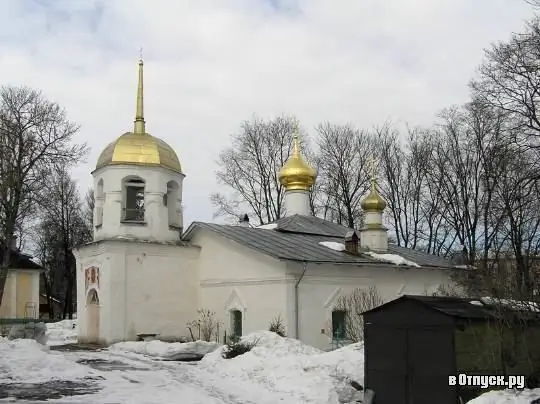
Description of the attraction
The Pskov church of Alexis from the field was built of stones and slabs after 1688 on the site of the ancient temple of the Alekseevsky women's monastery. Once it was located outside the city, in Pole, and it was surrounded by one-story wooden houses of the ancient Aleksevskaya Sloboda.
Back in time, in 1581, when Pskov was besieged by the troops of Stephen Batory, trenches were dug from the enemy camp to the monastery's Alekseevsky Church (where Batory's courtyard was located). From the church they went to the Pokrovsky and Svinorsky gates. Fierce battles took place here between the besieged Pskovites, who made frequent forays into the enemy's camp, and Polish troops. The monastery, after the release of the "Spiritual Regulations" (1721), was assigned to the Pechersk Monastery.
The warm side-altar of the Alekseevsky temple was built in the 18th century. In 1786, the church was assigned to the Sergius Church, other sources say that in 1788, by decree of the Pskov Spiritual consistory, on the contrary, the Sergius Church was assigned to the Church of Alexy.
By 1808, the church was badly dilapidated, and they were going to demolish it, but the Holy Synod did not allow this to be done. 6 years later, the church was assigned to the Old Ascension Monastery. Since 1854, the church has regained its independence. There were two thrones in it: the central one (in honor of the Monk Alexy, the Man of God) and the adjoining one (in the name of the Nativity of the Most Holy Theotokos). There was a cemetery at the temple. People who lived in the Alekseevskaya and Panova settlements, as well as the nuns of the Staro-Ascension monastery, were buried here. The bell tower was also built from a slab. It had nine bells: the big one weighed more than 42 pounds (672 kg), the second bell - 19 pounds (304 kg), the weight of the rest is unknown.
Parish guardianship existed at the church. In the parish, in the villages of Keb and Klishovo, there were two wooden chapels. The architect and the date of their construction are unknown. In 1900, a large number of courtyards (about 250) with almost 1,500 parishioners were located at the Alekseevsk Church. In 1917, Archpriest Mikhail Pospelov served in the church (information about him has not been found after this year). In June 1920, the administration department of the Pskov district-city executive committee drew up an act according to which the church was transferred to a religious society. In August 1927, the church cemetery was closed.
In 1938, the commission on cults of the Leningrad region, of which the Pskov province had been since 1927, decided to close the church. It was given over to a granary. During the Second World War, in November 1943, the Alekseevskaya Church was opened for worship. During the hostilities, it was damaged: the walls, roof, external and internal finishes were damaged. After the war, the church was renovated, then it was closed again and transferred to public organizations. In 1989, repair and restoration work was carried out. In 1994, the temple was transferred to the Pskov diocese. Since 1997, divine services have been held here on a regular basis.
Today's church of Alexis from the Field is white-stone, one-domed, with a deaf drum, the quadrangle is one-apse, in the interior it is pillarless, with a side-altar in the name of the Nativity of the Virgin. The two-tiered bell tower dates back to the 18th century and is located above the main entrance. On the portal of the entrance there is a new fresco depicting the Savior Not Made by Hands (created by the icon painter - Father Andrey). The blades divide the facades of the quadrangle, the apse is decorated with a curb and a runner. The temple with the oldest cemetery is surrounded by a stone fence of the 19th century.







